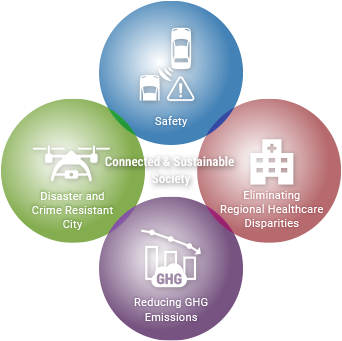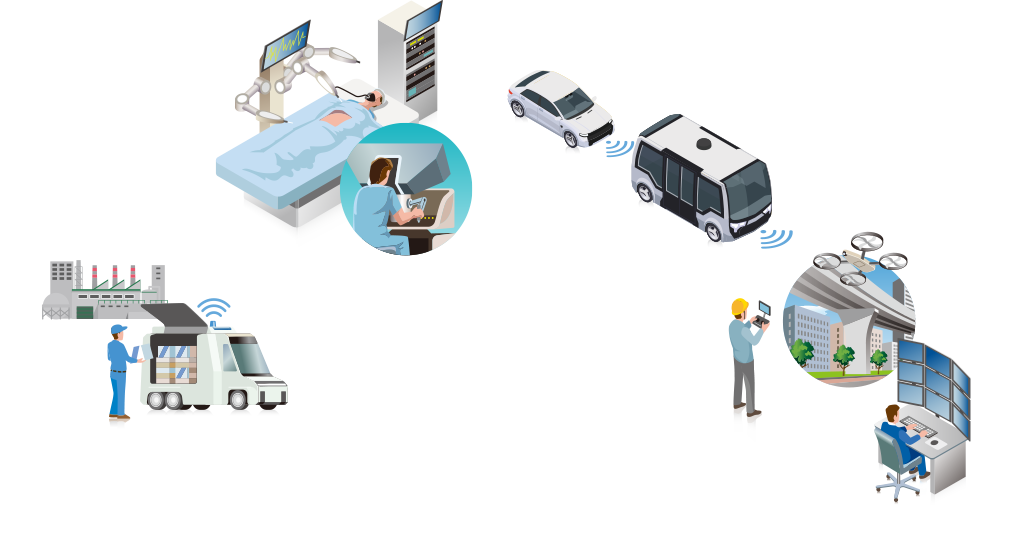Highlights 2023
 LAPEROS®
LAPEROS®
LCP Powerfully Supports
Next-Generation Communication Technology
It is said that the advance of IoT technology will usher in a “connected society”
in which not only smartphones and PCs, but also automobiles,
medical devices, and all things will be connected to the Internet.
That connected society will lead to a sustainable society.
However, next-generation communication technologies
that support a connected society are prone to radio wave loss,
and material properties for communication equipment are important.

Challenges of Next-Generation Communication Technology
Next-generation communication technologies such as 5G and 6G, which support the attainment of a connected society, will achieve ultra high-speed communications by using high frequencies that are wider than the conventional frequency ranges (band widths). However, the higher the frequency of radio waves, the more they are absorbed into other energy types, such as heat, causing transmission losses. Attenuation of radio waves due to transmission losses leads to communication delays, so it is important to suppress these losses in order to attain a connected society. A “connected society” is essential to attaining a sustainable society, as it enables remote surgery to eliminate regional medical disparities and autonomous driving to make transportation safer. As a result, this transmission loss has become a social issue.

Development of LAPEROS® LCP S125P
Therefore, materials with low dielectric loss tangent and relative dielectric constant are required as materials in telecommunication equipment. We have developed the new LAPEROS® LCP S125P grade as a material that meets those requirements. This S125P grade has a lower dielectric constant of approximately 1.0 or more
compared to common grades, resulting in lower transmission loss. Another major feature is that it combines LCP’s inherent properties of liquidity with low dielectric constant and low dielectric tangent. In the past, using additives to lower the relative dielectric constant and dielectric tangent resulted in lower liquidity. However, through
repeated analysis in the development stage and optimization of additive conditions, we succeeded in combining low permittivity and dielectric tangent with high liquidity. This allows for low dielectricity and low dielectric tangent, while also making it easy to mold small parts such as connectors, as is the case with ordinary LCP. The
LAPEROS® LCP S125P grade is expected to play an active role in more and more devices as high-speed communications become increasingly widespread, and is seen as a product that will support the attainment of a connected society.


Sustainable Society Attained Through Connecting
The construction of a connected society through high-speed communication technology is expected to open the way to a more convenient, safe, secure, and sustainable society. For example, it is expected to eliminate regional medical disparities through remote surgery, achieve a safe society through advanced automated driving technologies, develop safe cities that are resistant to disasters and crime through real-time video analysis using drones and sensors, and reduce GHG emissions by reducing the need for travel and optimizing logistics.

With the development of our new S125P grade, we now offer a wide range of products with relative dielectric constants ranging from 2.5 to over 10. As communication with high-frequency signals becomes more widespread, it’s expected that the needs of the market will become more diverse, and we are prepared to provide optimal solutions for a broad range of requirements. In addition to the properties of low dielectric constant and low dielectric tangent, materials in the high-speed communications field also require functional properties such as electromagnetic shielding and high thermal conductivity. We are responding to these needs by further developing materials using the polymer and compound technologies we have cultivated, and are supporting next-generation communication technologies with our wide range of approaches.



